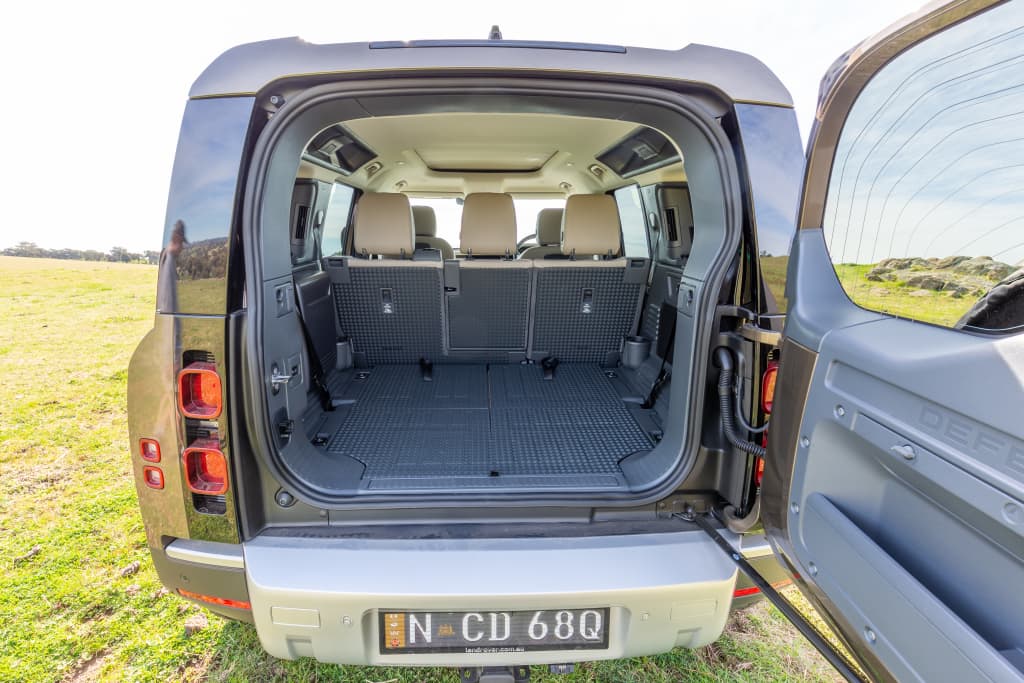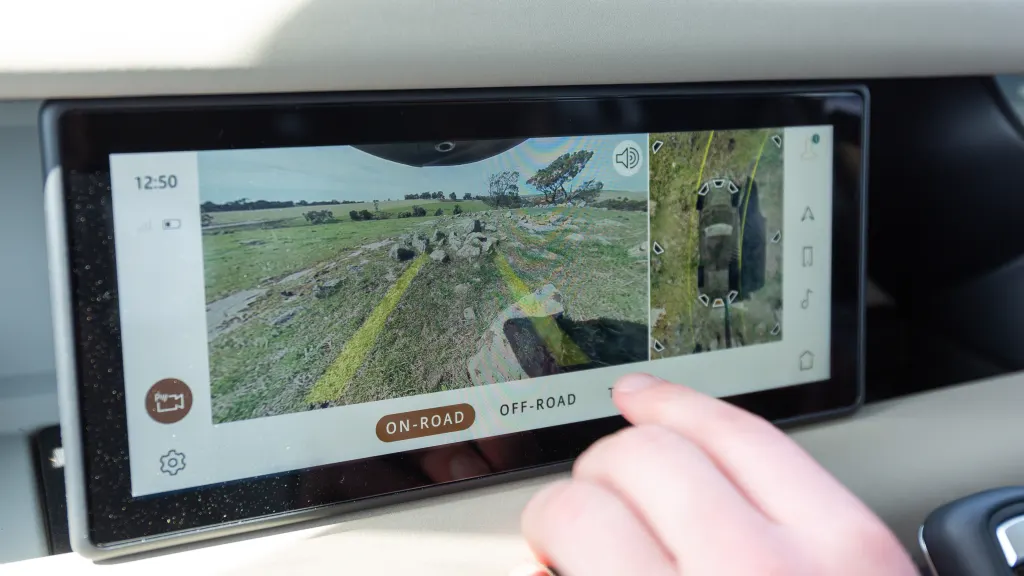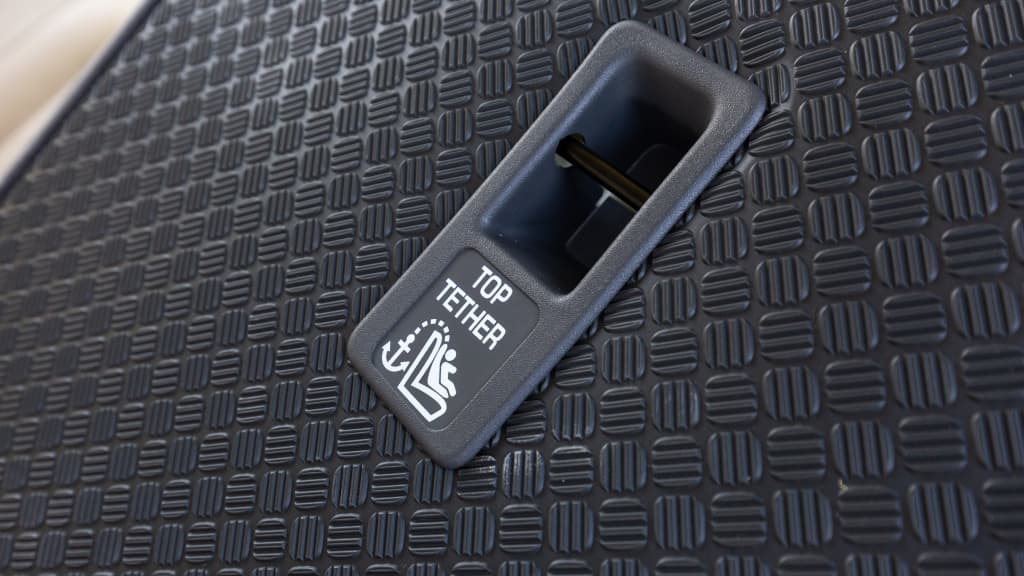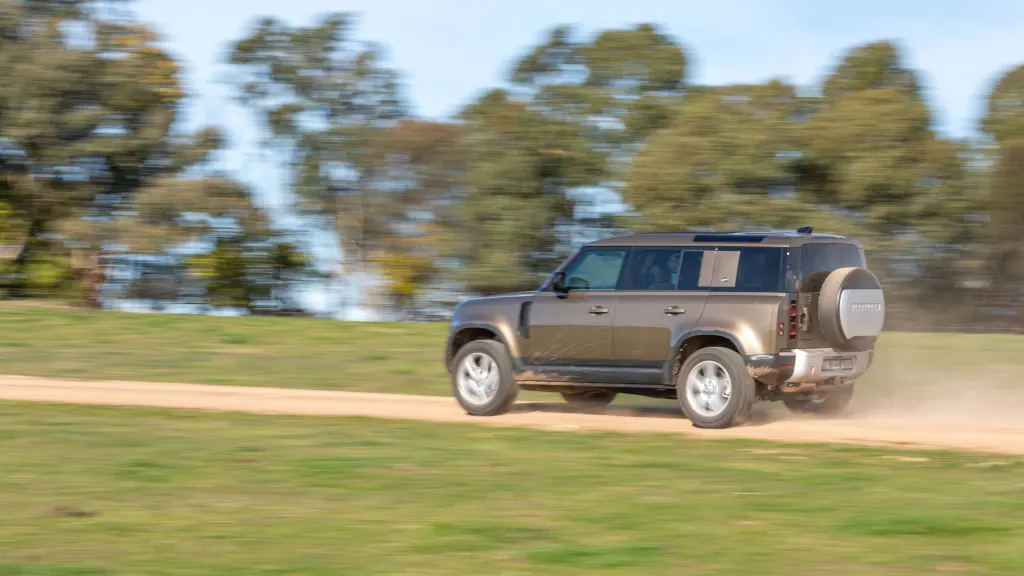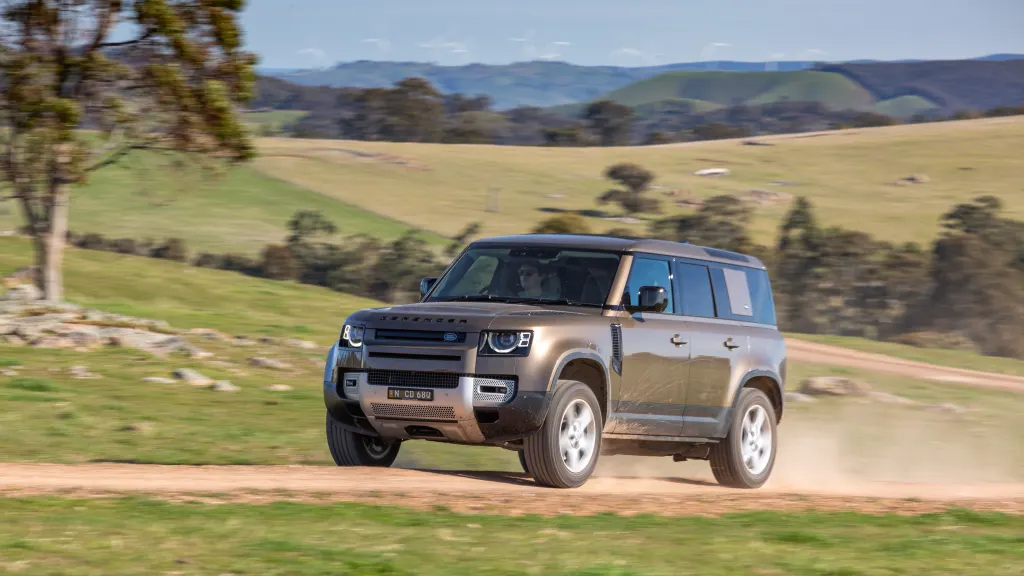The Land Rover Defender has long been held as an off-road hero, but for a price tag past six figures, can the new-generation car handle everyday life just as well?
Watch the Land Rover Defender in Episode 1 of Drive TV on Channel Nine and 9Now
- Super refined and powerful engine
- The interior’s blend of old-school character and new-school features
- Off-road technology allows beginners to get stuck in and have a go
- Big body still a bit of a struggle to deploy around town
- Steering wheel buttons not very user-friendly
- Smaller than expected boot space
Introduction
Few other brands are as steeped in off-road history as Land Rover. Perhaps Jeep is as revered, but when it comes to off-piste capability in addition to on-road liveability, Land Rover stands alone as the go-to marque.
It sets a demanding precedent jumping into the new 2021 Land Rover Defender – a modern reimagination of an off-road icon. And compared to its predecessor, this new car is a doozy! It comes in two body sizes (soon to be three), can be had in several specification levels with varying additional options packages, and with a choice between multiple petrol and diesel powertrains under the body.
It takes up the mantle as the British manufacturer’s most serious off-roader – as has been tradition with the Defender line – though this newbie can now count daily driver abilities, too, or so Land Rover would have us believe.
Such is the level of configuration of the new Defender, the resultant variant name ends up a little long and needs a bit of deciphering. On test we’ve collected a 2022 Land Rover Defender 110 SE D300, which is the larger five-door body (110), with the mid-tier kit (SE), and with a 220kW and 650Nm in-line six-cylinder diesel powertrain (D300). Then, in the words of a mid-Saturday-morning infomercial: but wait, there’s more!
On top of a $96,656 list price before on-road costs, this car is fitted with a folding fabric roof ($4810), the Family Pack that brings seating for seven and associated amenities ($4796), the Towing/Touring Pack ($4044), Gondwana Stone metallic paint ($2060), black exterior pack ($1400), privacy glass ($999), leisure activity key ($910), heated front seats ($806), rough-cut walnut trim ($598), and 60:40 rear seats with recline and slide ($572). Phew.
You can still see traces of the preceding Defender in the new design, though the new car updates the look with softer edges, LED lights, and alloy wheel designs. Of course, that’s just the start of it. It’s built on an all-new aluminium monocoque platform called D7x, which was needed to bring the Defender into the modern age. According to Land Rover, the chassis is three times stronger than the next best in market and can support 168kg of cargo on its roof when on the go. It’ll also tow 3500kg.
| Key details | 2021 Land Rover Defender 110 SE D300 |
| Price (MSRP) | $96,656 before on-road costs |
| Colour of test car | Gondwana Stone metallic ($2060) |
| Options | Folding fabric roof – $4810 Family Pack – $4796 Privacy glass – $999 Towing/Touring Pack – $4044 Leisure activity key – $910 Heated front seats – $806 60:40 seats with recline and slide – $572 Rough-cut walnut trim – $598 Black exterior pack – $1400 |
| Price as tested | $118,457 before on-road costs |
| Rivals | Jeep Wrangler Rubicon | Mercedes-Benz G-Class |
Inside
Between new and old Defenders, things inside the cabin have changed just as much as they have on the exterior. It’s received an extensive tech overhaul, stocks far nicer materials, and scores new features to help make daily drivability simpler.
That said, while it features all the technology and niceness you expect in 2021, there remains a certain uniqueness and old-school character in the presentation. The space is also as utilitarian as ever, with wash-out hard floors, hard-wearing fabric over the seats, and a neoprene-style fabric covering certain touchpoints.
The layout of the dash and centre console paves way for abundant storage options. Wherever you look there are shelves, cupholders, storage bins, hidey-holes, and small nooks. It makes the Defender far more appropriate for everyday life than it has ever been.
Space otherwise is very good throughout the car. Up front, the driver and passenger are treated to a comfortable, customisable seating position with a wide centre console between occupants.
The seats are firmer than most, but remain soft and pliant enough to endure long drives. There’s not a huge amount of support from the bolsters or seat bases – the seats are more sofa than bucket seats.
This is a very touchy-feely car, which sounds weird but feels good and presents nicely in practice. All surfaces of the car are covered in some interesting kind of material, with part-leather/part-fabric upholstery covering the seats, soft-touch effects to the dash and door cards, and rough-cut wood veneer panelling as a highlight.
However, it seems an issue that has long plagued Land Rover products has stuck around for the Defender. Some trim panels feel as though they’re not secured down to the premium level you’d expect. Some parts of the car creak awkwardly when going over off-road terrain too. It looks like a quality product, but perhaps just not put together as best as it could be.
Other quirks such as the doorhandles that have the keyless entry unlock button on the wrong end of the handle, as well as the gear selector that you really must intentionally slot into place, irked as user-experience misses.
I love the fabric sunroof that folds back on itself to reveal a wide aperture of light – proper safari style. It, as well as the roof skylights, allows for an ambient space in the second row where there’s plenty of light and space to sprawl out. Head room, leg room and space for your feet are well-covered, while amenities such as climate control, USB ports, and grab handles should keep back-seat bandits pleased. The wash-out rubber flooring is easy to clean too.
This Defender was optioned with the third row, which is accessed through fold-and-slide seats. It’s not the most graceful entry to the sixth and seven seats, but smaller occupants should have less drama getting into the space. It’s a tight and constrained place once you’re there, with no grab handles and few options for storage. Air vents do extend all the way back, luckily, with a fan control button to control airflow.
In standard guise with the third row flat, Land Rover says the Defender can fit 916L (“wet”). That expands to 2233L after the second row is flattened, but either way storage capacity isn’t as good as you’d expect from a large SUV. To help the space become more usable, Land Rover fits a switch that can lower the car and load height using the car’s air suspension, while the floor is covered in hard-wearing rubber.
| 2022 Land Rover Defender 110 SE D300 | |
| Seats | Seven |
| Boot volume | 916L (SAE measurement) |
| Length | 5018mm |
| Width | 2008mm |
| Height | 1967mm |
| Wheelbase | 3022mm |
Infotainment and Connectivity
The Defender’s dash layout features a 10-inch widescreen infotainment system called Pivi Pro. It runs a new-design interface and includes digital radio, Apple CarPlay and Android Auto functionality, and satellite navigation as standard.
It’s a crisp display featuring a nice gamut of colours and information. I was a little frustrated by the lack of a hard-coded home button, which only pops up on screen some of the time, though navigation throughout the menus is intuitive.
I loved the rear-view camera definition and 360-degree camera functionality, which displayed a fantastic high-definition image of what’s outside the car. This came in handy when reverse parking, though the camera feed also helps when off-roading.
There are a number of great features to the infotainment system, such as eco data, valet mode, and low-traction launch. One of my favourites was a dimensions screen that displayed the various dimensions of the car – a no-brainer!
The system can also update software and stream music over-the-air via an in-built data connection.
Elsewhere, there’s a digital instrument cluster ahead of the driver and tablet holders on the back of the front seats.
The steering wheel contains a series of touch-sensitive buttons controlling functions like cruise control and audio playback, but they’re a bit hit-and-miss. They have to be pressed intentionally – not just a light touch – and sometimes take a while to register that you’d touched them.
Safety and Technology
One area where the new-generation Defender has seen the most technological development is its level of safety equipment. New passive and active safety additions saw the Defender score a five-star ANCAP safety rating in 2020.
Standard safety equipment includes autonomous emergency braking, blind-spot monitoring, forward traffic detection, clear-exit monitor, lane-keep assist, 360-degree camera, rear collision monitor, traffic sign recognition, adaptive cruise control and driver-condition monitor.
The adaptive cruise-control system keeps a safe but steady distance from the car ahead, and is quick on the ball to react to changing speeds.
A switchable off-road mode selector gears the car up for different styles of terrain, with settings including Mud, Gravel, Grass, Snow, Rock and Sand.
| 2022 Land Rover Defender 110 SE D300 | |
| ANCAP rating | Five stars (tested 2020) |
| Safety report | Link to ANCAP |
Value for Money
In terms of other costs, the Land Rover Defender 110 SE D300 will set you back $2650 over five years for servicing. Jaguar Land Rover products are covered by a five-year/unlimited-kilometre warranty.
Roadside assistance will also be provided for that full five years, with the company saying it’ll even come get you if you become bogged or disabled on roads that only four-wheel drives can handle.
Against Land Rover’s 7.9L/100km combined fuel-consumption claim, during testing I saw a combined 10.6L/100km readout. That’s not horrible for a large off-road 4×4, though is nowhere near Land Rover’s claim.
| At a glance | 2022 Land Rover Defender 110 SE D300 |
| Warranty | Five years / unlimited km |
| Servicing costs | $2650 (5 years) |
| Fuel cons. (claimed) | 7.9L/100km |
| Fuel cons. (on test) | 10.6L/100km |
| Fuel type | Diesel |
| Fuel tank size | 89L |
Driving
Fitted to our Defender is a 3.0-litre six-cylinder diesel engine with twin turbochargers and mild-hybrid capabilities. While all diesel engines in the line-up use the same motor, the D300 specification features the highest outputs of all with 220kW and 650Nm to a constant four-wheel-drive system.
That’s good enough to send the Defender 110 SE D300 from zero to 100km/h in 7.0 seconds and on to a 191km/h top speed. In practice, the shove from the engine ensures you can overtake both around town and further afield with confidence. The eight-speed gearbox is smooth around town and responsive to changing throttle inputs.
The Ingenium engine, too, is incredibly refined and quiet in all driving applications. You could be forgiven for wondering whether, in fact, you’ve turned the engine on, such is its unassuming nature. The cabin experience stays hushed through country touring and on the freeway as little wind and engine noise permeates the interior.
Ride control is fantastic and supported by an air suspension system that can change the ride height between three preset levels. Pockmarked road surfaces are smoothed over without much complaint, and the chassis absorbs bigger mounds without translating impacts through to the cabin. This is an area where the current Defender has made great strides.
Handling-wise, the Defender stays with its roots and drives a bit agriculturally. It’s not a horrible experience by any means, though the tall centre of gravity results in some mid-corner lurchiness. This can be improved slightly by driving it in Access Height mode, but it’s hard to hide the 2471kg heft as it leans away from corners and takes time for the brakes to pull up. The steering strikes the right feel for the car – somewhere between light for manoeuvrability and the heavy feel of its predecessors.
Its inherent size isn’t the easiest to navigate around town either. Smaller drivers might have an issue seeing out over the tall bonnet and to gauge where the four corners of the car are at any given time. The view behind is blocked by headrests and vision out through the sides is blocked by the odd square-shaped panels of the C-pillar.
Luckily, the camera system is one of the best I’ve experienced in a long time. Between on- and off-road modes, the picture quality is top-notch and allows you to accurately gauge what’s going on outside the car. You can even get an outside-the-car perspective that shows the car in its contextual surroundings, which was super helpful when I spent time off-road.
Speaking of, I’m pleased that the Defender can handle the off-road as well as it ever could. We took the Defender to a grassy farm (spiritually where Land Rover cuts its off-road teeth), and I quickly found out the only limiting factor was the driver.
The air suspension set to Off-Road Mode monsters over all kinds of terrain and surfaces with wide approach and departure angles, while traction from the standard-fit Goodyear Wrangler all-terrain tyres is excellent. I ran up and down some steep hills and trudged through mud and wet grass without fear of getting stuck. Its ability to step up onto rocks and uneven surfaces is very high, especially for a car straight out of the showroom. Sure-footedness over gravel roads is also reassuring.
| Key details | 2022 Land Rover Defender 110 SE D300 |
| Engine | 3.0-litre six-cylinder twin-turbo diesel |
| Power | 220kW @ 4000rpm |
| Torque | 650Nm @ 1500-2500rpm |
| Drive type | Four-wheel drive |
| Transmission | Eight-speed torque convertor automatic |
| Power to weight ratio | 89.0kW/t |
| Weight | 2471kg |
| Tow rating | 3500kg braked, 750kg unbraked |
| Turning circle | 12.8m |
Conclusion
I went into my time with the Defender not knowing what to expect. Perhaps I was concerned about all the changes meddling with the Defender’s hard-earned character, but in earnest, the enhancements to the design and technology only help its cause.
Whereas the Defender of old embraced off-road situations with mechanical ingenuity, the new one handles the same situations with a slew of impressive technology. Its Terrain Response system has a setting for every situation you could find yourself in.
Our specification might push the price past the six-digit mark, and the options list might be a bit of a joke, but remember that this car can now operate across a broad range of roles.
It’s a comfortable car to roll about town in every day with enough space to store your life, the tech interface is beautifully presented, and a set of modern features will make sure buyers are happy for years to come. Also from an ownership perspective, this is the first time a Defender has brought on board advanced safety technology with an associated top-marks safety score.
The driving experience is better than it has ever been and stands tall against rivals like the Jeep Wrangler and Toyota LandCruiser Prado. With off-road prowess that’ll see you headed wherever you want to go, and an aftersales package where roadside assistance will come and get you once you do get stuck, that’s a fun package to own and use.
The Defender nameplate is finally brought into the 21st century with genuine on-road comfort and niceties that allow it to act as an everyday car – not just a bush-bashing weekender.
The post 2022 Land Rover Defender 110 SE D300 review appeared first on Drive.




















